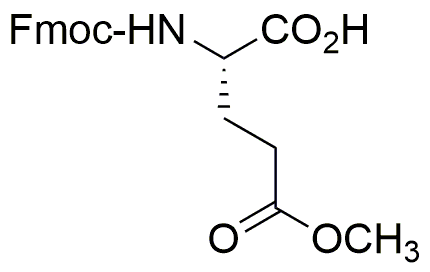Fmoc-L-glutamic acid g-methyl ester is widely utilized in research focused on:
- Peptide Synthesis: This compound serves as a key building block in the synthesis of peptides. Its protective Fmoc group allows for selective deprotection, facilitating the assembly of complex peptide chains.
- Drug Development: In pharmaceutical research, it is used to create peptide-based drugs. Its unique structure can enhance the bioavailability and stability of therapeutic peptides.
- Bioconjugation: This chemical is employed in bioconjugation processes, linking peptides to other molecules like antibodies or drugs, which is crucial for targeted therapy in cancer treatment.
- Research in Neuroscience: It plays a role in studying neurotransmitter functions due to its glutamic acid component, aiding researchers in understanding synaptic transmission and neuropharmacology.
- Protein Engineering: The compound is useful in modifying proteins to improve their properties, such as solubility and stability, which is essential in various biotechnological applications.
General Information
Properties
Safety and Regulations
Applications
Fmoc-L-glutamic acid g-methyl ester is widely utilized in research focused on:
- Peptide Synthesis: This compound serves as a key building block in the synthesis of peptides. Its protective Fmoc group allows for selective deprotection, facilitating the assembly of complex peptide chains.
- Drug Development: In pharmaceutical research, it is used to create peptide-based drugs. Its unique structure can enhance the bioavailability and stability of therapeutic peptides.
- Bioconjugation: This chemical is employed in bioconjugation processes, linking peptides to other molecules like antibodies or drugs, which is crucial for targeted therapy in cancer treatment.
- Research in Neuroscience: It plays a role in studying neurotransmitter functions due to its glutamic acid component, aiding researchers in understanding synaptic transmission and neuropharmacology.
- Protein Engineering: The compound is useful in modifying proteins to improve their properties, such as solubility and stability, which is essential in various biotechnological applications.
Documents
Safety Data Sheets (SDS)
The SDS provides comprehensive safety information on handling, storage, and disposal of the product.
Product Specification (PS)
The PS provides a comprehensive breakdown of the product’s properties, including chemical composition, physical state, purity, and storage requirements. It also details acceptable quality ranges and the product's intended applications.
Certificates of Analysis (COA)
Search for Certificates of Analysis (COA) by entering the products Lot Number. Lot and Batch Numbers can be found on a product’s label following the words ‘Lot’ or ‘Batch’.
*Catalog Number
*Lot Number
Certificates Of Origin (COO)
This COO confirms the country where the product was manufactured, and also details the materials and components used in it and whether it is derived from natural, synthetic, or other specific sources. This certificate may be required for customs, trade, and regulatory compliance.
*Catalog Number
*Lot Number
Safety Data Sheets (SDS)
The SDS provides comprehensive safety information on handling, storage, and disposal of the product.
DownloadProduct Specification (PS)
The PS provides a comprehensive breakdown of the product’s properties, including chemical composition, physical state, purity, and storage requirements. It also details acceptable quality ranges and the product's intended applications.
DownloadCertificates of Analysis (COA)
Search for Certificates of Analysis (COA) by entering the products Lot Number. Lot and Batch Numbers can be found on a product’s label following the words ‘Lot’ or ‘Batch’.
*Catalog Number
*Lot Number
Certificates Of Origin (COO)
This COO confirms the country where the product was manufactured, and also details the materials and components used in it and whether it is derived from natural, synthetic, or other specific sources. This certificate may be required for customs, trade, and regulatory compliance.


